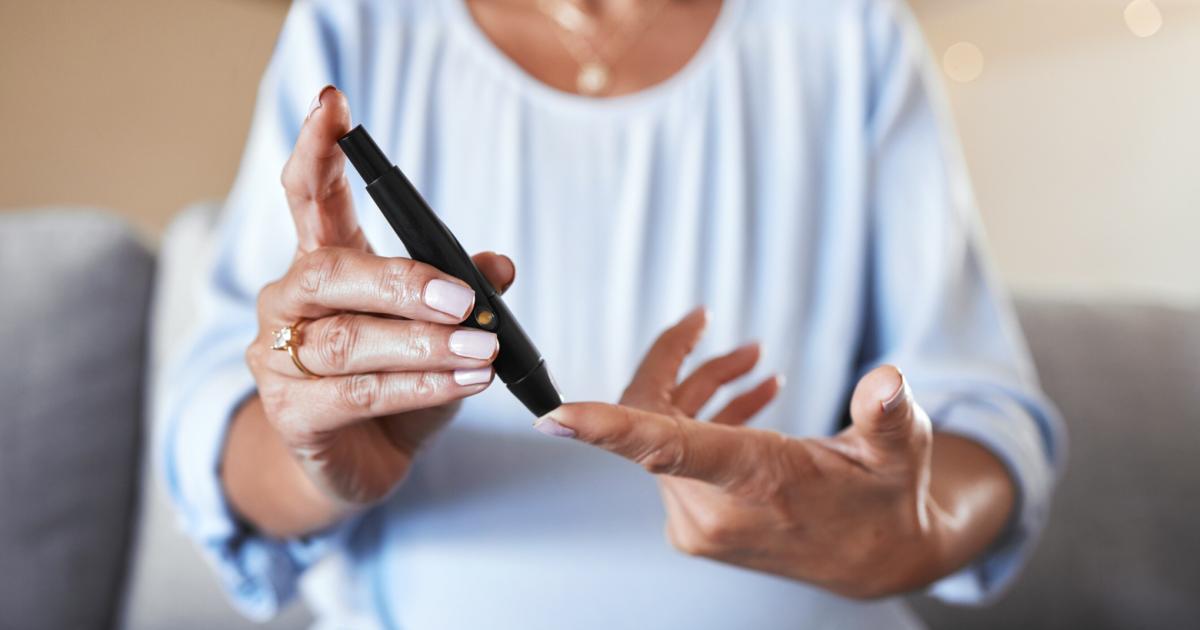

Diabetes mellitus can be defined as a metabolic disorder characterized by hyperglycemia or high blood concentration of glucose, resulting from the total lack or partial insufficiency of insulin. There are several types, although the most common are gravidarum or gestational diabetes, which arises during pregnancy; type 1 or childhood-onset diabetes, which involves a total lack of insulin and requires exogenous doses; and type 2 or maturity-onset diabetes, which involves insulin resistance and is treated, above all, with an adequate diet and avoiding a sedentary life.
Living with diabetes
According to the International Diabetes Federation, the disease in all its variants affects 425 million people worldwide. Likewise, the Spanish Diabetes Federation estimates that, in our country, there are six million people affected – 90% belong to type 2 – and it causes 25,000 deaths each year. More than two million Spaniards do not know that they suffer from it and only 59% of type 2 diabetes patients take the recommended treatment seriously.
Technology to be better
Digital services through mobile applications and devices are allowing patients to increase their quality of life. These tools provide exceptional help in the management of therapies, increase adherence to them and, thus, reduce the possibility of secondary diseases arising or amputations occurring.
It is estimated that there are around two thousand services of this type available to diabetics and that this will grow by 50% each year. A report prepared by Research2Guidance estimates that the mobile diabetes care market had a turnover of $97 million in 2021 and, In 2022, it reached 742 million dollars.

This gives us an idea of the importance that these specialized mobile applications already have and may acquire in the coming years. On the other hand, also according to Research2Guidance, its creators are changing their way of monetization. The current trend is to create connected services beyond apps. Instead of relying so much on downloads or in-app purchases, they are moving to subscriptions, with monthly fees of between 40 and 50 dollars that guarantee recurring income. They thus avoid the payment systems of Google Play or the App Store.
Are they really effective?
It has been shown that mobile applications aimed at diabetes management can have some clear benefits for their users. A study published in 2017, which evaluated 1,236 publications made on 1,263 diabetics undergoing treatment using software, concluded that Apps can help improve HbA1c control – meta-analysis of glycated hemoglobin. In addition, they reinforce the perception of self-care, by providing better information and education about patients’ health. Diabetics who use them also become more self-confident, since by using them they reduce their fear of not knowing how to treat possible episodes of hypoglycemia that may occur and improve their quality of life.

Other works prove that, despite the high number of tools of this type, their effectiveness can be improved. A recent study has tested apps in the majority languages of the ten countries with the highest rate of people with diabetes – China, India, the United States, Brazil, Russia, Mexico, Indonesia, Egypt, Japan and Pakistan. 3,374 Android and 4,477 iOS titles were identified. Within the first operating system, there were 1,019 apps dedicated to self-care – essential in patients with type 1 – and 1,303 within the second. 80% were in English or Chinese, and these were the ones with the most downloads and clinically relevant functions. But none met all the criteria for providing information and they did not cite accredited sources. Ultimately, this research demonstrates that these applications could play an important role in complementing multifaceted diabetes care, but they should be regulated, more specific and more adapted to the needs of users.
7apps2
In Spanish please
Researcher Marta Monje Vigón, from the University of Alcalá de Henares, in Madrid, has also evaluated the potential for self-care of the apps that exist in the Spanish-speaking market. She has reviewed 882 iOS and Android titles in Spanish and analyzed which ones conform to the guidelines established by the three clinical self-care guidelines on diabetes mellitus. Only eight were relevant to their research, which was based on 31 different criteria. The winner of her exam was Social Diabetes, followed by myDiabeticAlert and mySugr. In the case of those aimed at feeding diabetics, there is also a need to improve. According to another study, they are still in their preliminary development phases. In this field, the most popular and complete, with more than a million downloads, is Fooducate, that would meet eight of the ten requirements established by the researchers.
What I like the most
A report carried out in Wellington (New Zealand) showed that Younger patients are the ones who tend to download these types of tools. 87% of its users cited a glucose diary as their preferred feature. Additionally, the most in-demand non-existent feature was an insulin calculator, with 46% of respondents missing it. For their part, the health professionals interviewed also mentioned the diaries to measure blood glucose levels and the carbohydrate counter as their favorite functions. Six out of ten said they had recommended a diabetes app to their patients. Below, we’ve rounded up some of the best. Most have recording features and calculators, and connect with many glucometers on the market.
gluQUO (IOS AND AndroiD. Free, but with a monthly subscription of 2.99 euros or an annual subscription of 29.99 euros).
It has earned the nickname of the TripAdvisor of the diabetic community, because it incorporates a function called gluQUO Places that gives the possibility of finding, rating and reporting how your experience at a restaurant went from a glycemic point of view. The app stands out for its clean, simple and clear interface. Thanks to this application, it is very easy to add new detailed entries regarding what you are going to eat and where, the portions, grams of carbohydrates to eat, etc. It even offers the possibility of adding a photo so that we can remember more precisely the dishes and foods we have consumed. It also has a calculator that offers recommendations on the units of insulin to administer. Additionally, it advises on how many carbohydrates to eat each day. The data is exportable.
Social Diabetes (IOS AND Android. Free, but with a Premium paid option).
One of the best valued and most awarded, recognized as the best health app by UNESCO. Social Diabetes helps record data for the treatment of type 1 and type 2 diabetes, such as blood glucose, insulin, carbohydrates, medications, physical activity, weight, blood pressure or ketones . It has a bolus calculator – fast-acting insulin that is injected to correct specific hyperglycemia, for example, at meal time –, a carbohydrate calculator and a food list. It works with all types of glucometers and wearables, such as the Apple Watch or Fitbit. Likewise, it allows you to generate detailed reports and connect with medical professionals to monitor your health status.
mySugr (IOS AND AndroiD. Free, but with a paid Pro version).
Another great generic diabetes tracking app that connects with most glucometers, so you don’t have to do manual recordings. It has received several awards and has been recognized as a class 1 medical device in the US and EU. Like the previous ones, it controls meals, diet, medications, carbohydrate intake, blood glucose levels, etc. One of the strong points of mySugr is its customization options, regarding the registration window. Users can add, remove or reorder fields as they see fit. Includes some gamification elements, such as challenges to achieve personal therapy goals. Along the same lines, collect motivating comments that will encourage you to face type 1 and 2 diabetes.
7apps3
My IG – Glycemic Index and Load (Android. Free, but with in-app purchases).
A tool focused on good nutrition to avoid obesity and keep type 2 diabetes at bay. You can search for different foods to find out their glycemic index and glycemic load values, as well as their carbohydrate content. The free version allows for basic tracking, but for most features – such as CG and meal listings and calculators, statistics, reports, and import/export options – you’ll have to pay.
Diabetes on Demand (IOS and Android. Free)
A great alternative to manage your daily diet, sponsored by the IDIBAPS Research Center, the Alícia Foundation and ESTEVE. It has a carbohydrate calculator, equivalences for eating other things with a similar carbohydrate load and numerous very easy-to-prepare recipes, both for more traditional dishes from Spanish cuisine and from other cultures. Its most striking feature is the Plate Method, with which you can create varied and healthy menus adapted to people with diabetes and their families. You have the possibility of saving the menus that you like the most so that you can prepare them frequently. Diabetes à la Carte is also very attractive due to the use of realistic photos or images of the different foods to be combined.
Diabetes Forum (IOS and AndroiD.Free).
The largest forum for diabetics on your smartphone and a tool to not feel so alone on a daily basis. Of British origin, it is based on the diabetes.co.uk platform and has more than 250,000 registered users who share doubts and concerns about the disease, pass information and support each other. Its creators ensure that each question is answered in an average of just four minutes. Its biggest drawback is that it is not accessible in Spanish: it can only be consulted and used in English. Although, if you master the language of Shakespeare, you can enjoy a useful space that is on its way to hosting one and a half million publications.
Diabetika (IOS and Android. Free).
It is the app version of the online store of the same name, specialized in products for diabetics. The application allows you to find and directly buy accessories such as glucometers, needle sticks, insulin timers, wearables, food products and food supplements, glucose in different formats, emergency kits, personal care items and a long etcetera. It also gives the possibility to configure notifications and contact their customer service.

